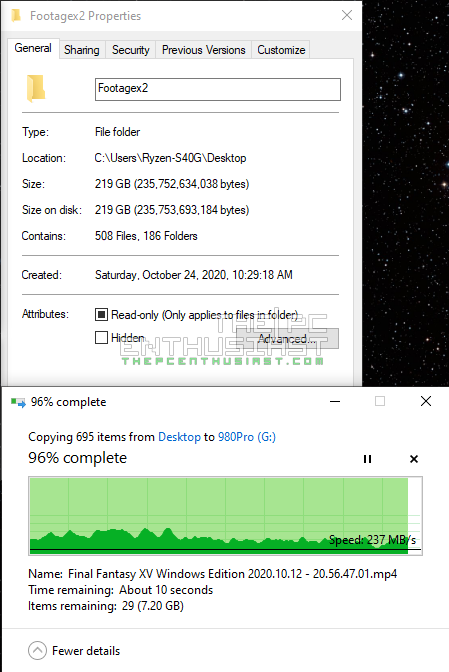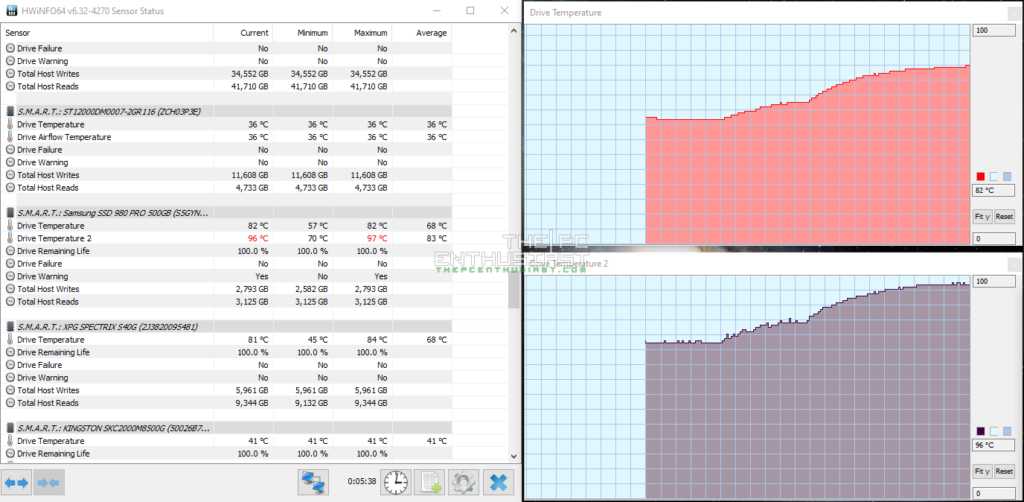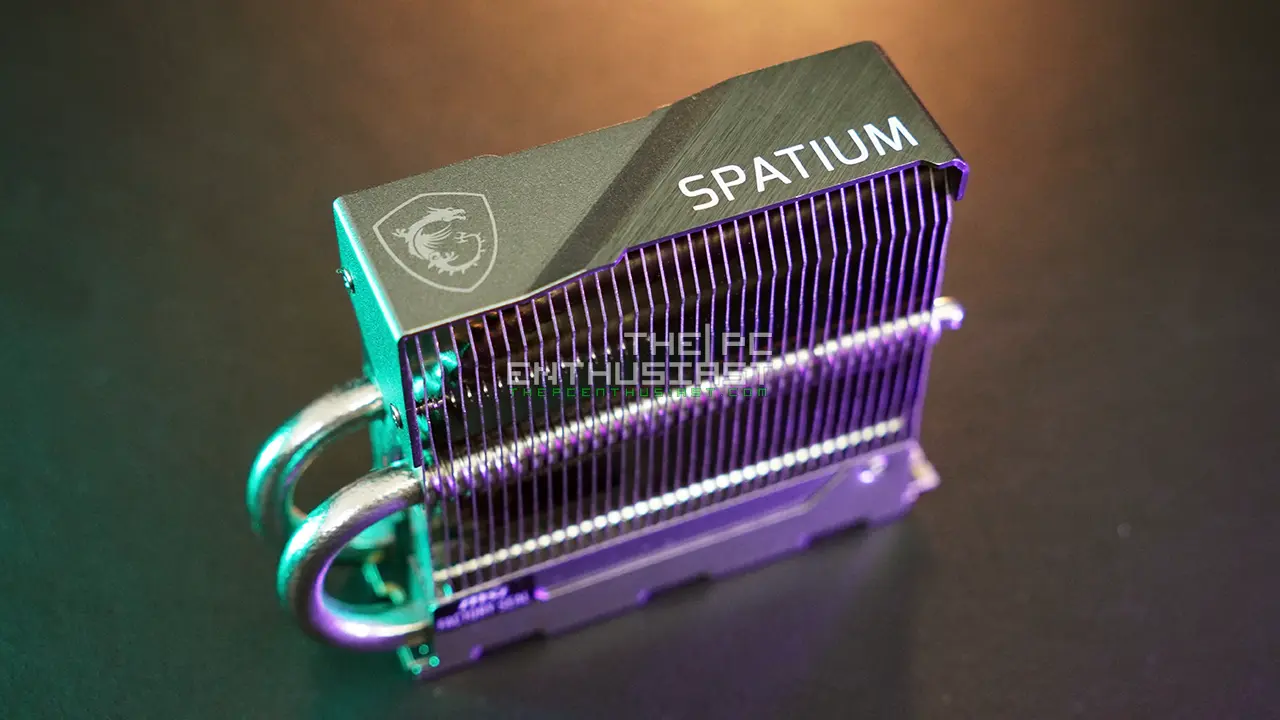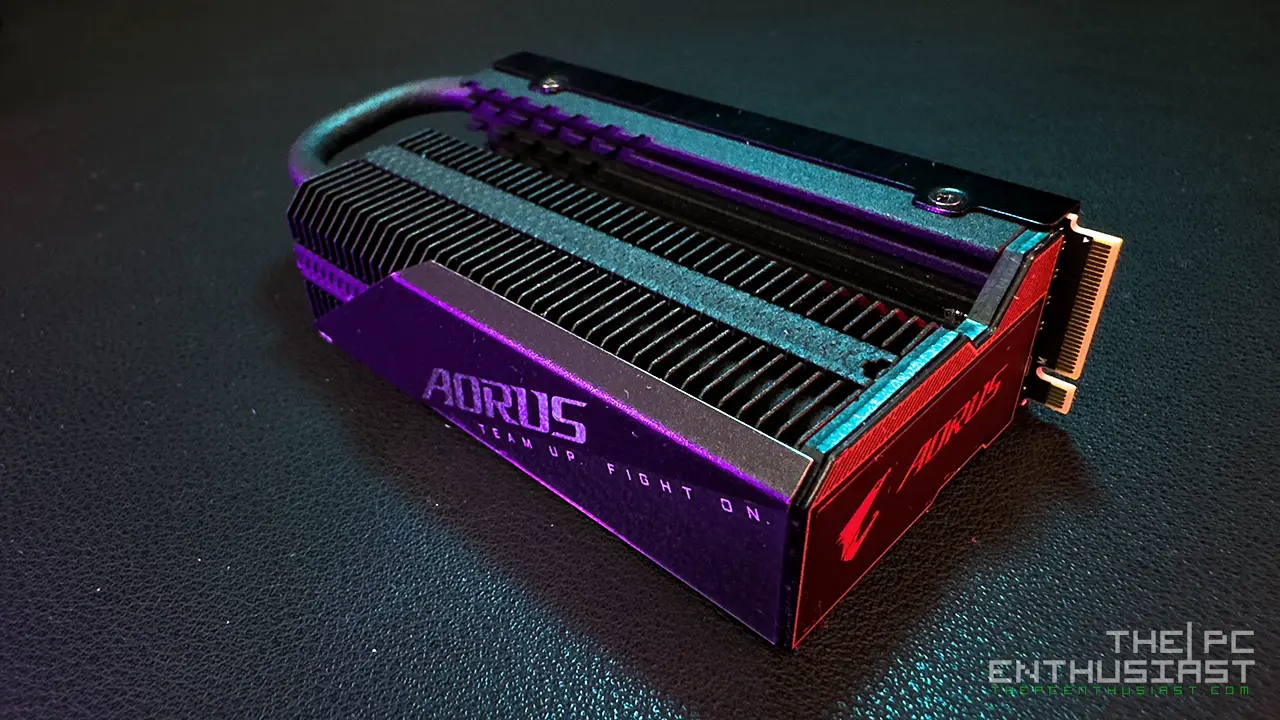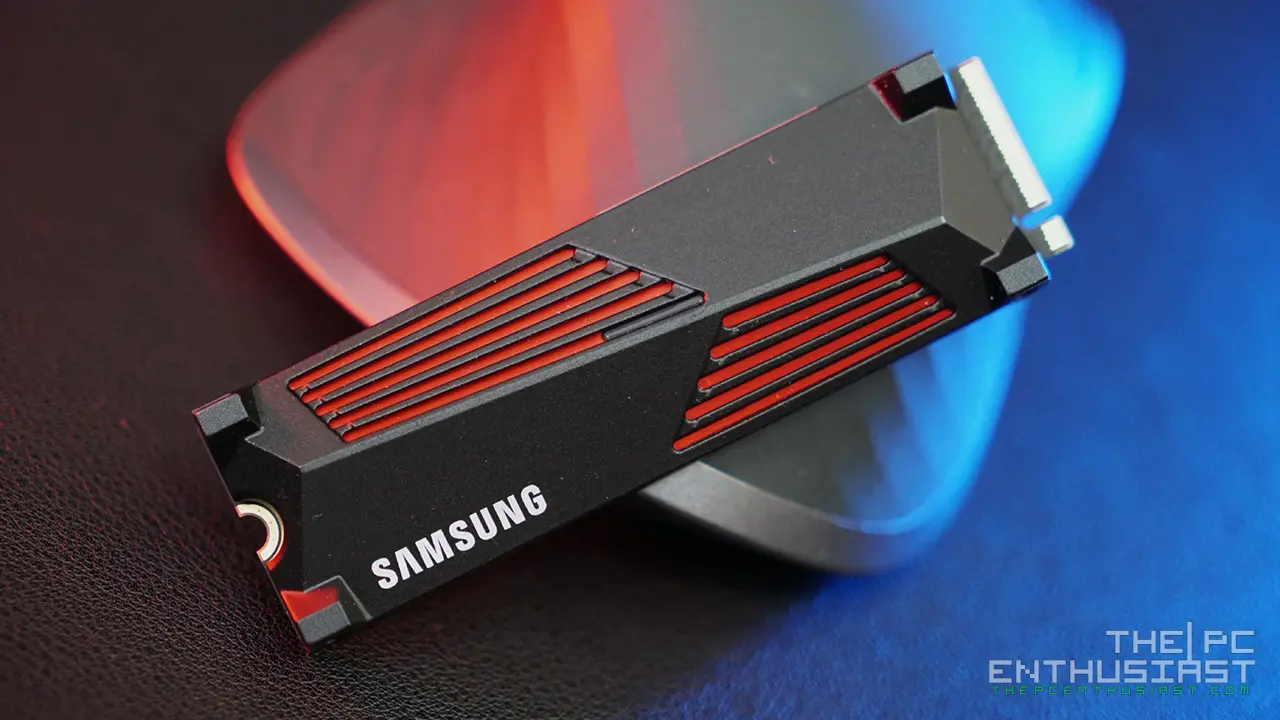About a month ago, Samsung released their latest, fastest, and new flagship storage solution – the Samsung 980 Pro SSD. The 980 Pro features Samsung’s latest 3-bit MLC V-NAND and new PCIe 4.0 Elpis controller and is the company’s first NVMe Gen4 SSD. They’re late to the Gen4 SSD party, but I’ll tell you later why they opted not to join the early Gen4 SSD bandwagon. The 980 Pro features speeds of up to 7,000MB/s, so is it (really) that better compared to 1st gen Gen4 SSDs? Should you buy one? Let’s find out in our Samsung 980 Pro review below.
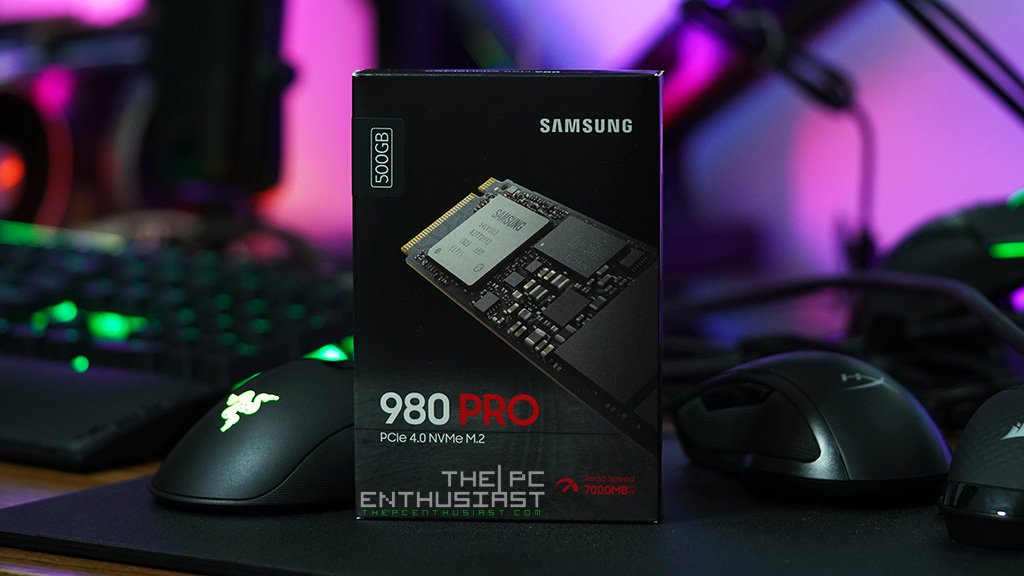
Samsung 980 Pro SSD Review – Features and Specs
Right off the bat, the Samsung 980 Pro SSD series features a new Elpis controller that can process 128 I/O queues simultaneously. It is about four times that of the previous Phoenix controller, with only 32 queues, and found in products like the 970 Pro and EVO Plus. According to Samsung, one single queue can consist of 64 thousand command sets; meaning a total of 128 queues can process over 8 million commands.
The new Samsung Elpis controller was manufactured using an “extremely fine” 8nm process. This is to “satisfy modern needs for high performance without compromising power efficiency”. With the new Elpis controller, the Samsung 980 Pro can reach up to 7,000MB/s sequential speed.
Perhaps one reason why Samsung didn’t join the Gen4 SSD bandwagon last year and prematurely released a 980 Pro is that the company was not satisfied with the performance increase that the early Gen4 SSD offered.
According to Samsung:
“However, in fact, the performance of PCIe 4.0 SSDs released in 2019 were never better than 5,000 MB/s for reads, 4,400 MB/s for writes. This is only 42% better than the previous PCIe 3.0 SSD’s 3,500 MB/s performance even though the bandwidth doubled. Samsung’s answer to this is the 980 PRO, which features up to 7,000 MB/s for reads and up to 5,000 MB/s for writes.”
The Elpis controller is paired with Samsung’s 6th Gen V-NAND flash chips. The new V-NAND adds around 40-percent more cells to the previous 9x-layer single-stack structure. This is achieved by building an electrically conductive mold stack comprised of more than 100 layers. Then vertically piercing cylindrical holes from top to bottom, creating uniform 3D charge trap flash (CTF) cells.
NAND flash chips tend to become more vulnerable to errors and read latencies as the mold stack in each cell area increases in height. To overcome such limitations, Samsung has incorporated a speed-optimized circuit design that allows it to achieve faster data transfer speed than the 5th gen V-NAND; at less than 450 microseconds (μs) for write operations and below 45μs for reads. Compared to the previous generation, this represents a more than 10-percent performance improvement, while power consumption is reduced by more than 15 percent.
With the new Elpis controller and 6th gen V-NAND flash, the Samsung 980 Pro SSD can deliver up to 7,000MB/s sequential read speed and up to 5,000MB/s sequential write speed. Or up to 1,000K IOPS of random read and write (4KB, QD32 Thread16).
Aside from the fast read and write speeds, the Samsung 980 Pro also features an enhanced Intelligent TurboWrite 2.0 technology. Compared to the previous Intelligent TurboWrite, Intelligent TurboWrite 2.0 provides up to 5 times larger buffer (TurboWrite region). Below are a table and diagram comparing the Intelligent TurboWrite (2.0) of the 980 Pro and the 970 EVO Plus.
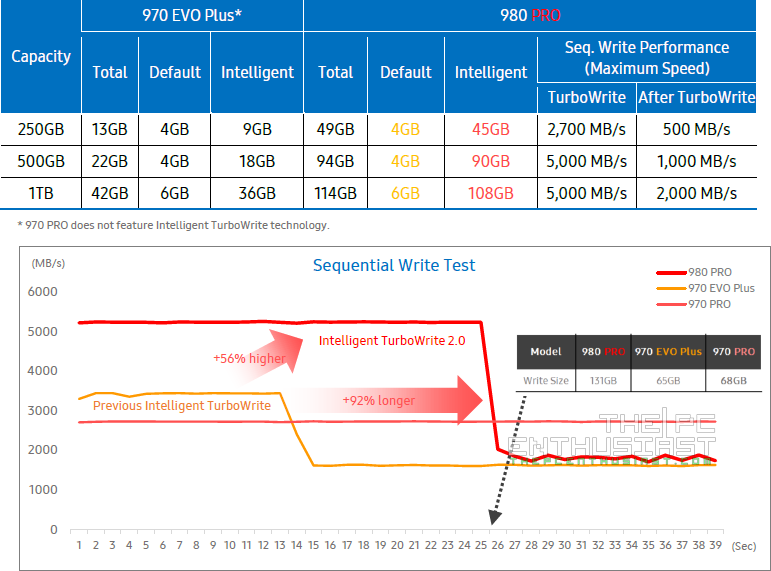
Just a note though. The Intelligent TurboWrite region takes advantage of idle capacity. This means that if the SSD does not have more than 324GB of free space for the 1TB model; intelligent TurboWrite will not fully operate. This algorithm does not affect SSD endurance, because the total amount of data users write on the SSD is unchanged.
The Samsung 980 Pro SSD series is available in 250GB, 500GB, and 1TB capacities. A 2TB variant will be available later in 2020. Samsung is also offering a 5-year limited warranty for the said SSD series. Below is a table showing the full specifications of the 980 Pro. After that, let’s take a look at the drive, then let’s see how fast it can go.
Samsung 980 Pro SSD Specifications

For Samsung 980 Pro latest pricing and availability:
For US: available at Amazon.com here
Global/US: available at Newegg.com here
For UK: available at Amazon UK here
Meet the Samsung 980 Pro
The new Samsung 980 PRO PCIe 4.0 NVMe M.2 SSD looks similar to the previous 970 Pro (Evo Plus) SSDs. It has a nice all-black design with red highlights, emphasizing that the SSD is a “PRO” series. The company has been using this same aesthetic and design for years, so I don’t think anyone would complain about it; even without a heatsink on top.
Speaking of the heatsink, the 980 Pro does have some thermal control solution as this SSD can get (really) toasty under load. I’ll show you the temps that I got in a moment. Under (extreme) workloads, thermal throttling could be an issue with these Gen4 SSDs. That’s why some M.2 Gen4 SSDs that you see on the market come with a heatsink, like the Corsair MP600 Gen4 PCIe or the Aorus NVME Gen4 SSD.
To mitigate this issue, Samsung has implemented three technologies that would help keep the temperature at bay. The 980 Pro has a heat spreader, a nickel coating on the Elpis controller, and a fine-tuned controller with advanced Dynamic Thermal Guard (DTG) technology. According to Samsung, “this trinity of excellent technologies” helps prevent the 980 Pro from overheating and maintain it’s expected performance.
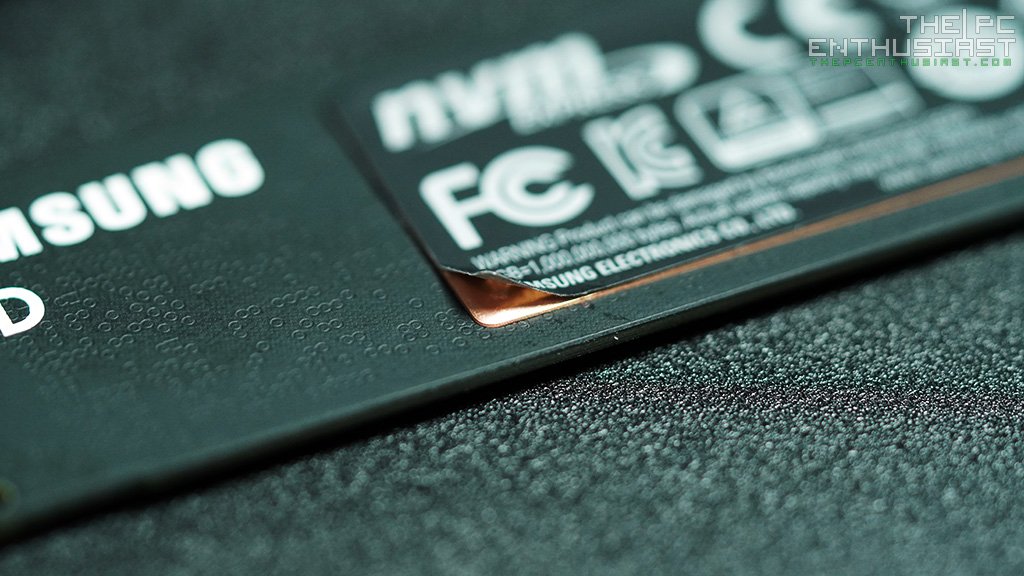
Above, you can see a copper heat spreader hidden beneath a sticker. It occupies more than half of the SSD. I’m not sure if that’s enough or perhaps they should have increased the size of the heat sink; but it sits right under (other side) the NAND flash chips. The Elpis controller has some kind of metal shielding to it. I guess that’s the nickel coating Samsung was referring to. So, does their thermal solution work? Let’s find out next.
The Test Setup
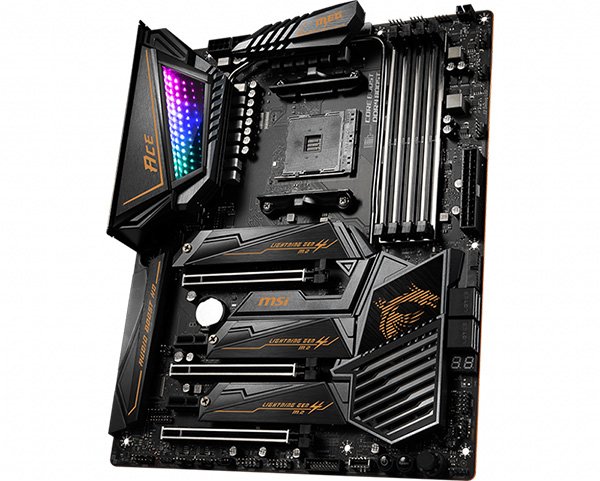
The Samsung 980 Pro SSD is a Gen4 SSD, so the only system that currently supports this type of SSD is an AMD X570 or B550 motherboard; powered by (at least) an AMD Ryzen 3000 CPU. Of course, the latest Ryzen Threadripper supports them as well. I tested the 980 Pro with an MSI MEG X570 ACE motherboard powered with an AMD Ryzen 7 3700X CPU.
Also, I only have the 500GB variant of the 980 Pro. It’s only rated at up to 6,900MB/s sequential read or 800K IOPS random read. It’s not the fastest in the series, but very close to the 1TB capacity. Below are the rest of the system’s specifications:
| Operating System | Windows 10 Pro 64bit version 2004 |
| Motherboard | MSI MEG X570 ACE |
| Processor | AMD Ryzen 7 3700X |
| CPU Cooler | Wraith Prism Cooler |
| Memory | Crucial Ballistix Elite 32GB DDR-4000 |
| Graphics Card | MSI GeForce RTX 2060 Super Gaming X |
| OS Drive | ADATA Spectrix S40G M.2 NVMe SSD |
| Power Supply | Seasonic Prime 850W Titanium |
Samsung 980 Pro 500GB Benchmark Results
Copy and Temperature Tests
I copied several videos from the ADATA Spectrix S40G to the Samsung 980 Pro 500GB. In the first one (left-hand side), the folder is only 109GB total. And in the second one (right-hand side), the folder is doubled, 219GB in total. I noticed a few things with this test. First is that the 980 Pro seems to be bottlenecked by the Spectrix S40G’s read speed. It’s only a Gen3 SSD and not the fastest either.
Second is that the performance of the 980 Pro dropped right before it almost completed copying the 109GB-sized folder. More or less, it has exhausted its 94GB total buffer (default + intelligent); that’s why performance went down.
So, I decided to double that folder, for a total of 219GB and see what happens. This way, we can also observe the 980 Pro’s temperature when dealing with such a large transfer/copy process. As you can see from the right-hand screenshot, the performance did go down after it has exhausted its buffer. Also, notice that the performance is somehow not consistent after around 100GB+ of files copied.
If we look at the 980 Pro’s temperature, we can see that its temperature went up to 97° Celsius. That’s pretty hot! Well, that would have been a bit ironic if I got 98° Celsius (980), get it? Anyway, joke aside, I think you do need to use a heatsink for the 980 Pro to help it more at managing its temperature.
Most X570 and B550 motherboards, especially the newer and higher-end ones, have a heatsink or heat shield for their M.2 SSD slots. I think it’s best to put the 980 Pro underneath a heatsink for more heat dissipation. And that’s what I did with my testing. I tested the 980 Pro 500GB with a heatsink. So it should provide the 980 Pro a bit more headroom or “best-case scenario” of performance at least.
Now let’s check out how it performs…
AJA Benchmark Results
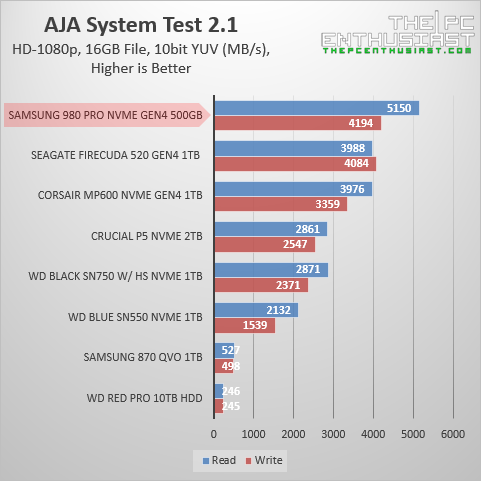
In AJA system test, we can see that the 980 Pro is faster than the Seagate FireCuda 520 when it comes to sequential read speed. But it was only able to edge out the FireCuda 520 by a little bit in write speed.
Anvil’s Storage Utilities Benchmark Results
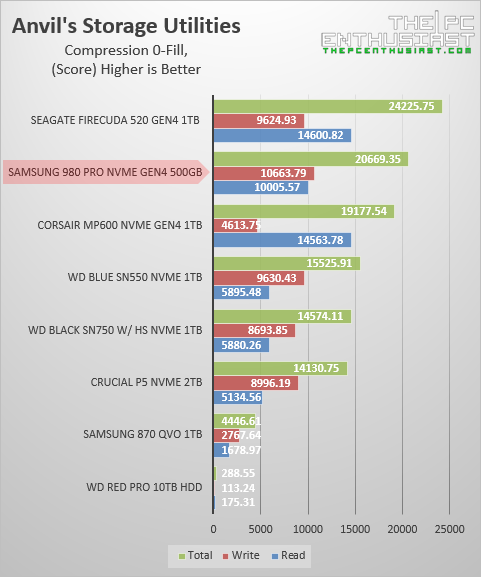
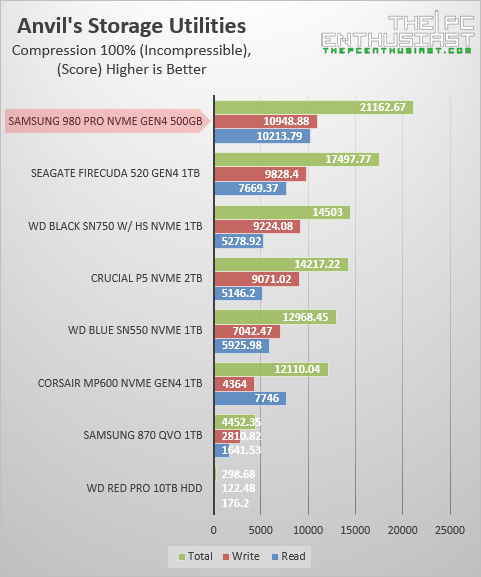
The Samsung 980 Pro trade blows in Anvil’s compressible test with the FireCuda 520. Seagate’s drive was a bit faster overall in that test; but got left behind when it comes to the incompressible test. The Corsair MP600, despite having a heatsink of its own, seems to be performing behind.
AS SSD Benchmark Results

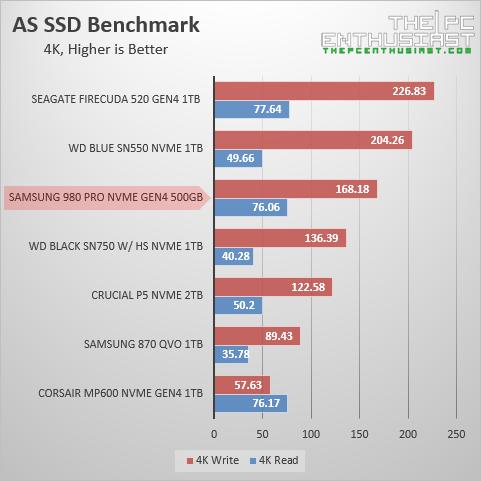
In AS SSD benchmark, the Samsung 980 Pro was performing faster when it comes to sequential read speed. But the FireCuda 520 was, again, a tiny bit faster during the sequential write speed. However, I’m not sure what’s going on with the 4K random test. We can see that the 980 Pro didn’t perform well in this test.
ATTO Disk Benchmark Results

By now, you are probably aware that ATTO disk benchmark shows the maximum theoretical speed of a storage drive. This is one reason why storage manufacturers use ATTO disk benchmark to advertise the speed of their drive. However, it doesn’t necessarily reflect the real-world performance, but only the highest potential speed.
In this test, we can see that the 980 Pro’s sequential read speed got 6,350MB/s; and its sequential write speed is around 4,880MB/s. Those are a few hundred megabytes short from the advertised 6,900MB/s read and 5,000MB/s write. Nevertheless, it is still close to the advertised speed.
CrystalDiskMark Benchmark Results
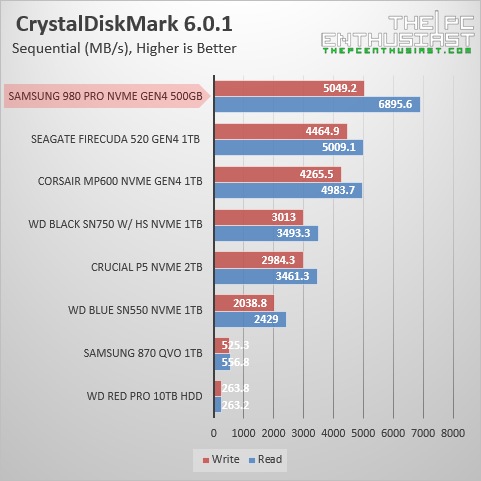
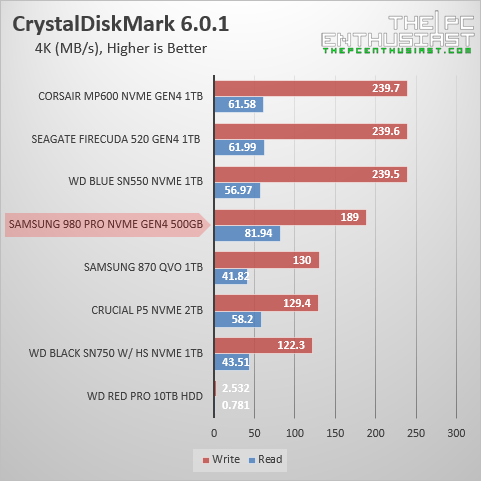
Up next, in CrystalDiskMark, we can see that the 980 Pro is faster overall in the sequential test, especially the read speed. But it falls short when it comes to the random test. Perhaps, the sequential performance is its best trait; but doesn’t perform well when it comes to random read and write.
ezIOmeter Benchmark Results

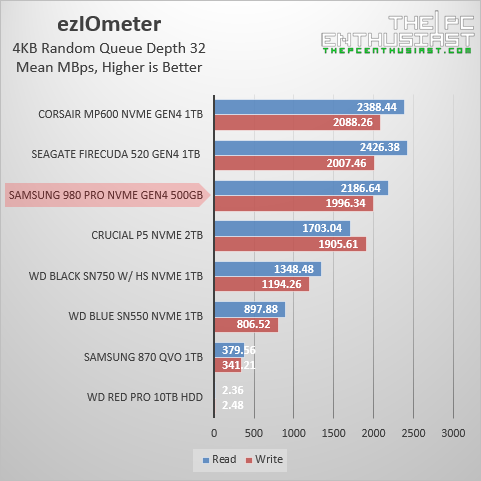
Again, in ezIOmeter, the 980 Pro performed well during the sequential test and trails behind when it comes to the random test. However, this time, we can see that the random performance isn’t that far from the other Gen4 SSD.
PCMark 8 Storage Benchmark Results
The last two tests will be a bit different and will be more intensive compared to the previous tests. The PCMark 8 Storage test is more intensive and uses a real-world scenario to test the drive. It tests the performance of SSDs, HDDs, and hybrid drives with traces recorded from Adobe Creative Suite, Microsoft Office, and a selection of popular games. It also highlights real-world performance differences between storage devices, unlike synthetic storage tests.

As you can see, the Samsung 980 Pro didn’t perform well in this benchmark test. One reason why I think it didn’t perform well is due to thermal throttling. PCMark 8 storage benchmark ran for more than an hour and I suspect that the 980 Pro was stressed a lot. That’s why the results were a bit underwhelming for a Gen4 SSD.
I ran the test again after a day to give it a fresh start. But the results were pretty much the same.
PCMark 10 Full System Drive Benchmark Results
Finally, I tested the Samsung 980 Pro 500GB with the PCMark 10 full system drive. This test uses a wide-ranging set of real-world traces from popular applications and common tasks to fully test the performance of the fastest modern drives. This will give us a more realistic expectation of a drive’s performance and a closer to a real-world testing scenario.
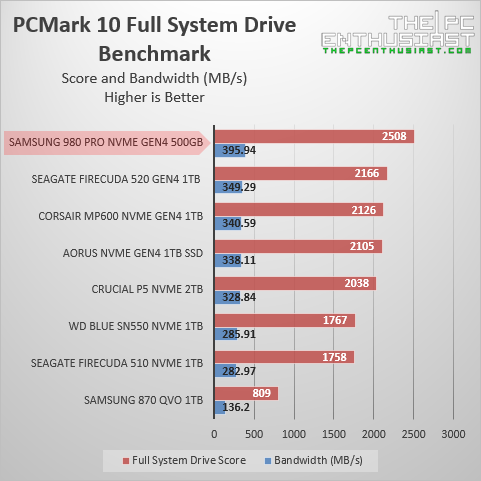
In this test, I got a more favorable result for the Samsung 980 Pro. Its overall score is the highest, at 2508; and it also got the highest bandwidth speed with 395.94MB/s. Between the PCMark 8, and PCMark 10 storage test, I would lean towards the PCMark 10 since it is the newer method and a more updated benchmark suite.
If you also notice, while the 980 Pro is indeed faster than the early Gen4 SSDs and other PCIe 3.0 NVMe SSDs, the difference is not that big. In real-world use, especially in gaming and normal desktop operation, you won’t feel the increased speed. Perhaps, when working with large file sizes or video files, when you import and export them, is where you can see or feel a bit of difference and improvement.
Time to wrap up this review.
Pricing and Availability
The Samsung 980 Pro SSD series is now available; except for the 2TB model, which will be available by the end of this year. The 980 PRO’s manufacturer’s suggested retail prices start at $89.99 for the 250GB model, $149.99 for the 500GB model, and $229.99 for the 1TB model. Samsung is also offering a 5-year limited warranty for the said drive. For the latest pricing and availability, kindly check out the links below.
Samsung 980 Pro latest pricing and availability:
For US: available at Amazon.com here
Global/US: available at Newegg.com here
For UK: available at Amazon UK here
Samsung 980 Pro NVMe Gen4 SSD Review Conclusion
The Samsung 980 Pro is the company’s first entry to the Gen4 NVMe SSD market. They are not the first or one of the first in the Gen4 SSD race, but their 980 Pro has the fastest sequential read and write speeds in the market. For reference, most early Gen4 SSDs in the market, like the Corsair MP600, Aorus NVME Gen4 SSD, and Seagate FireCuda 520, have similar performance. Their sequential read speed is up to 5,000MB/s and sequential write speed is up to 4,400MB/s.
One reason why the early Gen4 SSDs have similar performance is that they are made up of the same components. They have the same controller, which is the Phison PS5016-E16 controller; and the same 3D TLC NAND flash. Well, Seagate did tweak their controller a bit, and they are using a Seagate STXZP010BE70 controller.
On the other hand, Samsung is using a new in-house Elpis controller, paired with (also Samsung’s) 6th gen V-NAND flash. The 980 Pro is an all-Samsung storage solution through and through. This also means that you can expect, top-notch Samsung quality. Not to mention, the 980 Pro’s aesthetics is very nice with its all-black design.
While Samsung has put some thermal solution, like a heat spreader at the back and nickel coating for the Elpis controller; I still think that it is best to use the 980 Pro with a heat sink for additional cooling. My 980 Pro 500GB, without additional cooling, reached 97° Celsius during during copy test.
When it comes to performance, I find that the Samsung 980 Pro is generally faster compared to other Gen4 SSDs in the market. Although, it does trail behind when it comes to random performance, at least in my tests. It also comes with an AES 256-bit hardware encryption and a long 5-year warranty. The only thing that you need to watch out for is the current price; and if you think you would benefit from the speed or not.
For now, PC games wouldn’t benefit much and if you simply want a fast M.2 NVMe SSD for normal desktop operation, you might be better off choosing a cheaper alternative. One question that pops into my mind is, what kind of performance will get from a “980 EVO” if ever Samsung decides to release such a product soon. Will it be a QLC-based SSD, since the 980 Pro is already using TLC? Time will tell…
Anyway, at the end of the day, the Samsung 980 Pro is currently the fastest or one of the fastest M.2 NVMe Gen4 SSD available in the market. And if you are hunting for the fastest M.2 SSD drive, this is Samsung’s solution for you.





